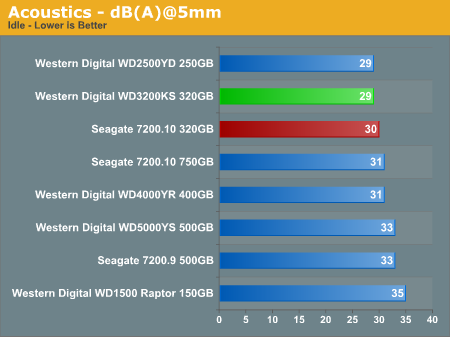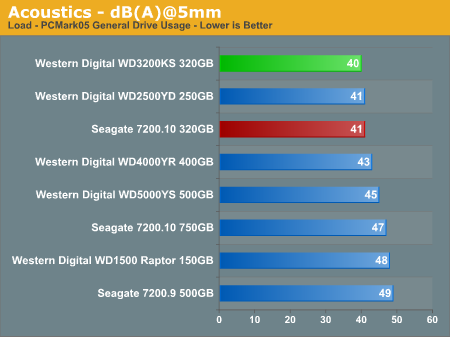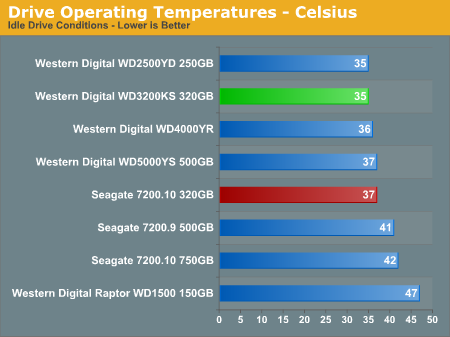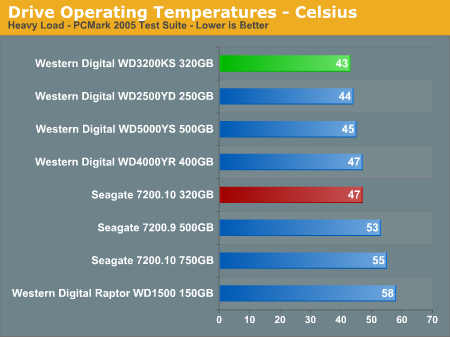Western Digital and Seagate: 320GB Grudge Match
by Gary Key on July 27, 2006 2:00 AM EST- Posted in
- Storage
Hard Drive Acoustics
Our acoustic test utilizes our standard test bed components but we enable AMD's Cool'n'Quiet technology and turn off the case fans to isolate as much case noise as possible during testing. Our OCZ power supply is virtually silent in these tests along with our fanless Asus 7600GS video card providing a further decrease in our case's acoustical ambience. Our drives are attached to the drive cage with rubber bushings to assist in isolating the noise of the drive without creating harmonic changes due to the case design
Our acoustic tests are designed to measure the decibel levels while the system is at idle and also under load while running the General Hard Disk Drive Usage benchmark within PCMark 2005. We found through trial and error this particular benchmark produces controlled readings across a wide range of applications within the benchmark. This particular benchmark utilizes 60% reads and 40% writes within the trace playback file.
The measurements are taken at a distance of 5 millimeters from the rear and front of the drive being tested in order to minimize surrounding environmental noise. The reported measurements are based on an A-weighted decibel score that measures frequencies similar to the way the human ear responds to sound. We take a total of three measurements for each test. We then subtract the high and low scores and arrive at our findings by reporting the remaining score.


The WD3200KS is overall the quietest drive we have tested to date. The Seagate 7200.10 320GB drive follows closely behind and improves upon the 750GB drive in the objective test results. Our subjective opinion is that the seek requests are very muted for both drives and it was difficult to near impossible to notice the drive's noise levels over the power supply fan during the majority of intensive read/write requests. The Seagate 320GB drive did not generate the thumping noise we encountered with the 7200.10 750GB drive. Our base db(A) level in the room at time of testing was 24 db(A).
Hard Drive Thermals
Our thermal tests utilize sensor readings via the S.M.A.R.T. (Self-Monitoring, Analysis and Reporting Technology) capability of the drives and are reported by utilizing the Active SMART 2.42 utility. We test our drives in an enclosed case environment without the front fan operational to simulate temperatures that could conceivably be reached in a SFF or HTPC case design. We typically find the reported numbers drop anywhere from 18% to 25% on average when the front fan is operational.


We expected the WD3200KS to run cool based upon our test results with the other Western Digital drives. It did not disappoint us in either test as even the casing remained somewhat cool to the touch after hours of continuous testing. As already stated, these results were recorded in our enclosed Gigabyte case without the front fan operating and represent something of a worst-case scenario. Our base temperature level in the lab at time of testing was 23 degrees Celsius.
The Seagate 7200.10 320GB improves significantly upon the 750GB version in thermals and makes a respectable showing against the Western Digital drives. However, at idle the Seagate is 2 degrees Celsius and under load 4 degrees Celsius hotter than the WD 320GB drive with the casing becoming hot to the touch after continuous usage. Looking strictly at the acoustic and thermal benchmarks we definitely would recommend the Western Digital drive for a silent or HTPC system.
Our acoustic test utilizes our standard test bed components but we enable AMD's Cool'n'Quiet technology and turn off the case fans to isolate as much case noise as possible during testing. Our OCZ power supply is virtually silent in these tests along with our fanless Asus 7600GS video card providing a further decrease in our case's acoustical ambience. Our drives are attached to the drive cage with rubber bushings to assist in isolating the noise of the drive without creating harmonic changes due to the case design
Our acoustic tests are designed to measure the decibel levels while the system is at idle and also under load while running the General Hard Disk Drive Usage benchmark within PCMark 2005. We found through trial and error this particular benchmark produces controlled readings across a wide range of applications within the benchmark. This particular benchmark utilizes 60% reads and 40% writes within the trace playback file.
The measurements are taken at a distance of 5 millimeters from the rear and front of the drive being tested in order to minimize surrounding environmental noise. The reported measurements are based on an A-weighted decibel score that measures frequencies similar to the way the human ear responds to sound. We take a total of three measurements for each test. We then subtract the high and low scores and arrive at our findings by reporting the remaining score.


The WD3200KS is overall the quietest drive we have tested to date. The Seagate 7200.10 320GB drive follows closely behind and improves upon the 750GB drive in the objective test results. Our subjective opinion is that the seek requests are very muted for both drives and it was difficult to near impossible to notice the drive's noise levels over the power supply fan during the majority of intensive read/write requests. The Seagate 320GB drive did not generate the thumping noise we encountered with the 7200.10 750GB drive. Our base db(A) level in the room at time of testing was 24 db(A).
Hard Drive Thermals
Our thermal tests utilize sensor readings via the S.M.A.R.T. (Self-Monitoring, Analysis and Reporting Technology) capability of the drives and are reported by utilizing the Active SMART 2.42 utility. We test our drives in an enclosed case environment without the front fan operational to simulate temperatures that could conceivably be reached in a SFF or HTPC case design. We typically find the reported numbers drop anywhere from 18% to 25% on average when the front fan is operational.


We expected the WD3200KS to run cool based upon our test results with the other Western Digital drives. It did not disappoint us in either test as even the casing remained somewhat cool to the touch after hours of continuous testing. As already stated, these results were recorded in our enclosed Gigabyte case without the front fan operating and represent something of a worst-case scenario. Our base temperature level in the lab at time of testing was 23 degrees Celsius.
The Seagate 7200.10 320GB improves significantly upon the 750GB version in thermals and makes a respectable showing against the Western Digital drives. However, at idle the Seagate is 2 degrees Celsius and under load 4 degrees Celsius hotter than the WD 320GB drive with the casing becoming hot to the touch after continuous usage. Looking strictly at the acoustic and thermal benchmarks we definitely would recommend the Western Digital drive for a silent or HTPC system.










20 Comments
View All Comments
patentman - Monday, July 31, 2006 - link
To avoid superparamagnetism, engineers have been increasing the coercivity, the field size required to write a bit, of the disc media. These fields are limited by the magnetic materials making up the write head that will soon effectively limit drive sizes utilizing longitudinal recording. Although additional capacities are still achievable, the drive industry will be moving to perpendicular recording technology shortly as longitudinal recording has basically hit the proverbial brick wall after being utilized for nearly 50 years."I wrote a pretty detailed post on the anandtech forums about this a while back. You can check it out http://forums.anandtech.com/messageview.aspx?catid...">here" (I used to post under the nickname "klaviernista"). Considering I examined and issued a lot fo the patents that are the basis of seagate's perpendicular technology, I think I am more than qualified to speak on the matter.
Oh, and for the record, the "soft" magent under layer is never truly "written to" during the reocrind gprocess. The soft magnetic underlayer is made of a material that has magnetic domains which rotate easily in response to an external magentic field. When the write field goes across any given point in the medium, it induces the field in the corresponding point on the soft magentic underlayer to rotate perpendicular to the medium. The article is correct in saying that the result is a substantial increase in write field intensity, but neglects to mention that the fields of the soft magnetic underlayer to not remain oriented perpendicular to the media surface after the write field from the magentic head is removed, whereas the fields in the magentic recording layer do remain oriented perpendicular to the media surface.
The whole point of usuing a soft magnetic underlayer is to allow magnetic materials with very high coercivity to be used as the recoprding layer. Why do you need a very high coercivity recording layer in high density recordng media? See the post I linked to above and read the discussed about "intergranular exchange coupling."
jackylman - Thursday, July 27, 2006 - link
In the pulldown menu, accoustics -> acousticsSonicIce - Thursday, July 27, 2006 - link
Even with an extra platter to lug around, the Western Digital was quieter and cooler!madfly - Thursday, July 27, 2006 - link
if you want to have the seagate hard drive cross shipped where they send you a replacement and you return the defective one back to them they charge $25, considering the hard drive cost $99, that there is a ripoff. I had this happen to me with a 250GB HD that I bought last year, so I'll be spending my money with one of the others unless the deal is ridiculous.Mana211 - Thursday, July 27, 2006 - link
SPCR uses 1 meter (aka 1000mm or 200 times your stated distance) to measure SPL."Each drive is measured for SPL one meter away from the top of the hard drive. Hard drive noise tends to be directional, the loudest position being directly over the top. SPL readings typically drop by 2~3 dBA/1m when measured from the side of the drive. The drive is placed on a soft foam to ensure that no vibration noise is produced during testing."
The there is an entire category of sounds you hear at 5mm that wouldn't be noticable from outside a case.
Take this quote from SPCR: "Consider the distance of Hardware.fr's recording microphone: 5cm from the HDD. This is a serious problem. There's no way the decibel reading can be accurate due to boundary effects. It's the same problem at storagereview.com -- not even relative differences are necessarily correct due to compression effects; the close proximity impacts every measurement similarly, reducing differences."
http://www.silentpcreview.com/article631-page1.htm...">http://www.silentpcreview.com/article631-page1.htm... shows that the new audio recordings (not to be confused with the SPL Dba numbers) will use two recording distances:
* One meter so that "nominal" volume, audibility, and sound character can be judged.
* One foot (or 30 cm if you will) to capture all the details from even the quietest noise sources.
tuteja1986 - Thursday, July 27, 2006 - link
Western digital for me since i want a quiet and cool drive.crydee - Thursday, July 27, 2006 - link
The WD400YR and WD500YS seem very close to performance with the Raptor, but I can't find the WD400YR on pricewatch on newegg also I read about the WD drivers having a high rate of doa?AdamK47 3DS - Thursday, July 27, 2006 - link
The Seagate drive has a performance advantage with the two 160GB platters. Anandtech is still ignoring the advantages of higher platter densities. Why is that? Platter density is one of the features I look at when purchasing a new drive. It's a good indication of performance when compared to another drive of the same total capacity. You have two 320GB drives reviewed with different number of platters and yet there is no mention of this other than the table. It's very odd.evilharp - Thursday, July 27, 2006 - link
Check your "price bot" settings. Currently you list the following deals for a "Western Digital Caviar® SE16"I followed the Business Computing Network link (simply due to the crazy price) and it is for a 20 unit bulk purchase.
Booty - Thursday, July 27, 2006 - link
On the last page it should be listed that the WD has a 3 year warranty for retail and 1 year for OEM - you have them switched.